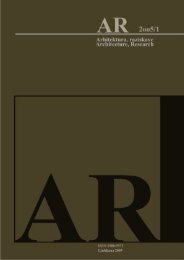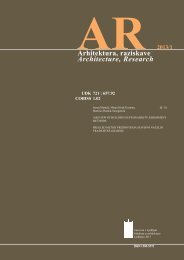AR 2010/2 - Fakulteta za arhitekturo
AR 2010/2 - Fakulteta za arhitekturo
AR 2010/2 - Fakulteta za arhitekturo
- No tags were found...
Create successful ePaper yourself
Turn your PDF publications into a flip-book with our unique Google optimized e-Paper software.
Biljana Arandjelović, Ana Momčilović-PetronijevićArhitektura vodnih mlinov v južni SrbijiThe Water Mills Architecture in the South of Serbia<strong>2010</strong>/2 <strong>AR</strong>UDK 725.2 : 664.71.05 (497.11)COBISS 1.02prejeto 15. 9. <strong>2010</strong>izvlečekVodni mlini so bili do polovice 20. stoletja gosto posejanipo podeželju južne Srbije. Njihova arhitektura je posebna,v glavnem so zgrajeni v regionalnem moravskem stilu. Nažalost pa so bile te enkratne zgradbe <strong>za</strong>voljo brezbrižnosti nele <strong>za</strong>puščene, ampak večinoma tudi opustošene. Po <strong>za</strong>slugiugodnih naravnih pogojev so se mlini na tem območjudomnevno nahajali že v starem veku. Obstajali so skozi vessrednji vek. Zemljiški posestniki so imeli navado samostanomin cerkvam podarjati vasi in hkrati z njimi tudi vodne mline. Zatakšne mline je veljala posebna pravna ureditev. Srednjeveškizgodovinski viri poročajo, da so poleg samostanskih incerkvenih vodnih mlinov obstajali tudi mlini v lasti celih vasiali vaških okrožij. Proti koncu turške vladavine in med obemasvetovnima vojnama je število prebivalstva po vaseh naraščalo.Zato je bila tedaj zgrajena večina vodnih mlinov. Običajno sojih postavljali na tistih odsekih rečnih dolin, kjer so bile brzice.Vodo iz rečnih strug so s pomočjo kanalov speljali do potrebnevišine vodnih mlinov. En kanal je lahko oskrboval dva, tri alicelo šest vodnih mlinov.ključne besedevodni mlini, dediščina, zgodovina arhitekture, izročila,etnografija, moravski stilabstractThe water mill structures were very frequent in the ruralterritory of south Serbia until the half of 20th century. Theirarchitecture is unique, and mostly in the regional Morava style.Unfortunately, due to neglect these unique structures were notonly abandoned but in most part devastated. It is supposedthat they existed in these areas as early as in the ancient times,due to the favorable natural conditions. The land lords used tobestow villages to monasteries and churches, and with them,sometimes, the water mills. For such water mills there werespecial legal regulations. In the medieval historical sources,apart from the monastery or church water mills, there werethose belonging to entire villages or village districts. In nearpast one could find a favorable river location for a watermill without the actual water mills. The population swelledin villages, in the periods nearing the end of the Turkish rule,and between the two world wars. For this reason, the majorpart of the watermill was constructed then. The water millswere usually constructed at those parts of river valleys withrapids. From the riverbeds, water was conducted, by meansof flumes to the required height of the water mills. One flumecould accommodate two, three even six water mills. The watermills remained what they used to be in the ancient past: form,structure, certain parts with names, order, manner of usage etc.key wordswater mills, heritage, history of architecture, traditions,ethnography, the Morava styleAccording to archeological research, sets of mill stones intendedfor grain milling occur very early. They were made of a slightlyconcave lower stone (bed stone) and cylindrical or convex upperstone (runner). The remained this form, unchanged for a verylong time. A small figurine from Egypt, from the time of 5thdynasty (around 2500 BC) represents a servant woman who,kneeling mills the grain on a large, slightly concave stone slabby using her both hands on a smaller, rounded stone. At a sitein China, in the Gobi desert, a large number of smooth millstones was found dating back to 4000 BC. In Serbia, such millstones dating back to 4700 BC were discovered in Lepenski Vir.Probably the oldest such stones, well dressed and polished, werediscovered in Libyan part of the Sahara, whose age is estimatedto around 14 000 years.It cannot be positively certain when the transition to a millcomposed of two circular stones, of which the rotation of theupper one mills the grain, took place. It is certain that this couldnot happen prior to discovery of the wheel.Hand-driven, rotating mill was very wide-spread and remainedin use for a very long time, almost until present time. S early asin the 3rd century BC the first hand-driven mills were found.In the same century, near the city Arles, the first water-drivenmill was constructed. The water fell from the height of 20 mand drove 8 mill stones. Soon after, the water-mills were beingconstructed all over Europe.In the Slavic people, the mills were found in Poland dating backto the 1st century BC. In the long period of its usage, the designwas improved: the runner got two handles mounted oppositeto one another, which made operation easier, and later a deviceadjusting the fineness of the flour was invented – a verticallever lifting and lowering the runner. Regardless of the designimprovements, the milling was a hard work performed almostexclusively by women. (Findrik, 1983)The Roman mill, though the same in working principle with theother milling facilities, had somewhat a more complex structure,for which reason it could not spread widely to other regions. Itconsists of two parts, the upper and the lower. The upper or outeris a hollow stone cylinder, narrow around the middle. The loweror inner stone is in a shape of circular cone, on which the upperstone rests. The upper part – stone was movable. A wooden shaftwhich drove the millstones by transmitting the beast or manualpower passed through its narrowest part. The grain was run intothe upper, hollow part of the cylinder, and the flour issued fromthe along the entire edge of the lower part, which was incasedin a lead hurst.Slika 1: Rimski mlin na vodni pogon (Findrik, 1983).Figure 1: Roman mill – driven by water; (Findrik, 1983).The Romans used water to power the mill. The Mill mechanism59

















